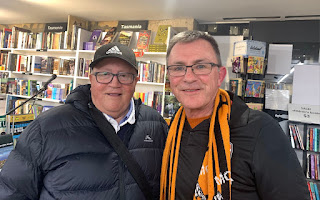Photo: Adam Muyt's wonderful new book, "Clogball", available at all good book stores. [PlessPix]
Adam Muyt’s latest book, “Clogball”, is an important book because it is both a sports history and migrant history about the Dutch in Australia.
The Italian, Croatian and Greek contribution to Australian football is well recognised.
The Dutch influence has arguably been just as great, but because the Dutch have tended to assimilate more readily than those other groups, it has not been as well recognised.
Tasmanian resident, Muyt, is an excellent historian and an accomplished writer.
His previous book was a history of the Fitzroy AFL club, now the Brisbane Lions.
“Clogball” is the result of meticulous research and travels over Australia to interview ‘Dutchies’ and their descendants and to look at documents and mementos
I first met Adam through historian Ian Syson in the old heritage-listed grandstand at a game at South Hobart Oval.
Photo: Adam Muyt (left) and Dr Ian Syson in the old grandstand at South Hobart Oval. [PlessPix]
I watched many games from that grandstand as a kid.
Dad took me there every weekend and I saw several great ‘Dutchies’ and the team Hollandia.
As stated above, the Dutch integrated much more readily than other European migrants, so many of them ended up playing for non-Dutch clubs.
That was particularly so in Tasmania.
South Hobart was where I first saw the likes of Peter Mies (Northern Juventus), Adrian Harmsen (Metro), John Steenhuis (Caledonians), Paul De Schipper (South Hobart), who were all stars of the local game.
Harmsen, in fact, was an Australian international. Eleven ‘Dutchies’ played for Australia in the 1950s and 1960s and he was the only one from Tasmania.
In all, there were 38 Dutch clubs in Australia and they won 170 senior men and women’s titles in the past century. In this, they rank 4th behind the Italian, Greek and Croatian clubs.
In 1947, there were 2,174 ‘Dutchies’ in Australia. There were another 125,000 by 1961 and, after 1961, there were another 40,000
They comprised the third largest non-English speakers in Australia.
2.12% of the Tasmanian population has Dutch heritage, the largest percentage of any Australian State.
By the mid-1980s, less than 10 Dutch clubs remained.
Photo: Author dam Muyt (right) at the launch of "Clogball" at The Hobart Book Shop. [Photo courtesy of Adam Muyt]
Since starting as a reporter in 1979, I have seen numerous excellent players of Dutch ancestry.
I have mentioned the ‘Dutchies’ I saw as a kid. Later, as a player and a reporter, I got to see and know the Compagnes from the North-West Coast, the Mies from the North, and the Huigsloots, Herweynens, Groenewouds, Zeitzens and Kruijvers from the South.
They all had an enormous and positive impact on Tasmania football.
Muyt has done justice to the Dutch involvement in, and influence on, football in Australia, and indeed in Tasmania.
This book is must-read for people interested in football history.
Adam Muyt kindly asked me to launch his book at The Hobart Book Shop on 17 August, which I gladly did.
I was pleased to meet one of my former students, who now owns the bookshop.
One of the attendees was Liz Elliott (nee Vervoort), who was a Dutch immigrant in 1981 (she played for Metro) who was selected for the Australian Women’s Football team, now known as the Matildas, in 1986 for an Oceania international tournament in New Zealand.
She was unable to go on tour, however, because she found out she was pregnant. There went her chance to earn an Australian cap.
The daughter she gave birth to was with her at the launch.
Photo: Noah Mies (right), the third generation of the Mies family to play at the highest level in Tasmania. The player on the left is Clarence Zebras' Dutch import, Pritchard Adjei. [PlessPix]
In closing my talk at the launch, I mentioned the fact that Ulverstone was a hotbed of Dutch influence on Tasmanian football.
I shall never forget watching the Netherlands play Australia on television in a 1992 Olympic qualifier in Utrecht, Holland.
As the camera panned the packed stands, there was a group of Dutch supporters holding aloft a huge banner that read: “Hello Ulverstone”.
That was a clear indication of the football links between The Netherlands and Australia and, in fact, Tasmania.
1992 was the 350th anniversary of the Dutch explorer Abel Tasman sighting Tasmania.
I was writing for “The Mercury” at the time and a crazy idea entered my mind.
Could the Netherlands play a game here against Tasmania or Australia to celebrate that anniversary?
Not in Sydney or Melbourne, but in Hobart.
Johan Cruyff was coach of Barcelona at the time and many Dutch players were world names in football.
I never pursued the idea, and even if I had, it would probably never have happened.
Photo: The reviewer launching Adam Muyt's book at The Hobart Book Shop on 17 August 2023.
But one has to dream big in football, and what a coup that would have been.
Perhaps the idea can be resurrected and pursued in 2042, the 400th anniversary?
The Socceroos never play in Tasmania. Imagine if The Netherlands were to play here against Tasmania.
It’s a dream, but one that Adam’s outstanding book may help to keep alive.
Adam Muyt, “Clogball: The Dutch and Soccer in Australia - A Migrant Story”, (The Vulgar Press, 2023), 386pp, $45.

.jpg)



No comments:
Post a Comment